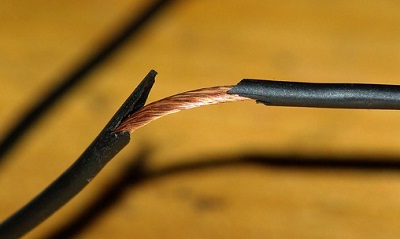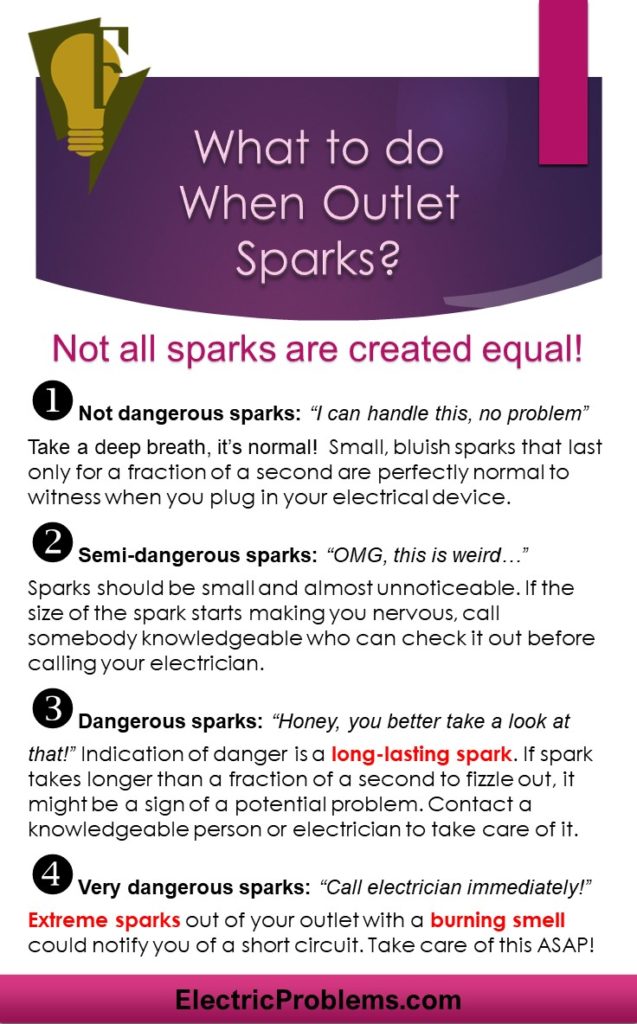What to do When Outlet Sparks?
DISCLAIMER: AS AN AMAZON ASSOCIATE I EARN FROM QUALIFYING PURCHASES. THIS POST CONTAINS AFFILIATE LINKS THAT WILL REWARD ME MONETARILY OR OTHERWISE WHEN YOU USE THEM TO MAKE QUALIFYING PURCHASES. FOR MORE INFORMATION, PLEASE READ MY EARNINGS DISCLAIMER.
|
If you encounter a dangerous spark, that follows a flipped circuit breaker, the best thing to do is NOT touch anything that is connected to that particular circuit and call the licensed electrician to handle it. If a small spark comes down from your outlet when you plug something in, it is very common and is nothing to worry about.
All our electrical devices and electronics require electricity in order to be useful. At some point, we all experienced an outlet spark in one way or another but did not consider it to be dangerous at all. But some sparks make us shiver…
“Not all sparks are created equal! “
Here a list of what types of sparks we encounter and what we usually think when we see them:

- Not dangerous sparks. “I can handle this, no problem.”
- Semi-dangerous sparks. “OMG, this is weird…”
- Dangerous sparks. “Honey, you better take a look at that!”
- Very dangerous sparks. “Call an electrician immediately!”
Having basic electrical knowledge can be useful to determine if the spark is dangerous or not. Sparks come in all shapes and sizes and some are more dangerous than others, so let’s go over them.
Different types of outlet sparks
It is very useful to know what type of spark are we dealing with in order to take proper actions. So, what makes a spark dangerous?
- It’s color
- It’s size
- How long it holds
- Frequency of the spark
- Does it trigger a burning smell?
It is usually intuition telling you that “that particular spark is something to worry about”. We all experienced “safe” sparks, and if we notice something extraordinary, we start to worry…
#1. Color of the spark.
Small, bluish sparks that last only for a fraction of a second are perfectly normal to witness when you plug in your electrical device. If you notice a spark of any other color than that (ex: white, yellow, orange), this would be the first sign of trouble with your wiring or outlet.
#2. Size of a spark.
Sparks should be small and almost unnoticeable. If the size of the spark starts making you nervous, call somebody knowledgeable who can check it out before calling your electrician.
#3. How long the spark lasts.
Indication of danger is a long-lasting spark. If spark takes longer than a fraction of a second to fizzle out, it might be a sign of a potential problem.
#4. Frequency of spark.
It is also good to pay attention if you get noticeable sparks EVERY time you plug something in.
#5. Spark with a burning smell.
This should not be happening! In this dangerous situation, you should call a licensed electrician ASAP! What causes sparks? Read on…!
NEVER do this (video below) when you see scorch marks on your outlet without shutting the main power down first! A bucket of water here will NOT solve your problem:
Why do outlet sparks happen?
The problem with wiring is the most common issue with your outlet, this is why it sparks. Overloading your circuit is the second most common situation.
#1. Short circuit (dangerous situation).
If the wiring in your circuit gets frayed and a hot wire touches the ground or neutral wire, it will create something that is known as a “short circuit”. Short circuits will draw extra current from your power source and if the breaker is not triggered, it will overheat or damage any equipment that you will try to plug in.
Extreme sparks out of your outlet with a burning smell could notify you in advance if you have this problem. In a worst-case scenario, your house could get on fire, in the best case, you quickly shut the main power down and call local electrical services.
Potential problem: Fire!
Solution: Call your electrician immediately!
#2. Circuit overload (semi-dangerous).
This is not such a scary situation because you have full control over it! Your home is divided into several different circuits that are controlled by breakers in the main panel.
There could be one or more outlets on the same circuit. If you plug in too many devices into the same circuit (which is easy to do since you don’t always know which outlets work together), your power line gets overloaded.
If the circuit breaker did not flip, but you noticed a warning sign in the form of weird sparks out of your outlet, just remove some of the devices from a circuit.
Problem complexity: Not too dangerous
Solution: Ask your significant other NOT to use a hair drier while the heater or A/C is running on the same circuit.
#3. Water damage (very dangerous).
If water comes in contact with electricity, as a result, you will have a short circuit, which could be the reason why you see lots of sparks coming out of your outlet.
Sometimes we don’t really know that there is a flood problem above us until we see electricians showing up at our door and asking if we have any problems with electricity. In this type of situation, your breaker usually gets flipped if you try to plug something in or your ground fault circuit interrupter (GFCI) will cut off the power.
If you do notice that someone left their faucet open above you and your ceiling is leaking or you come home and your floor is wet, call plumbing services and electrician immediately! They should be able to solve this problem in a timely manner.
Potential problem: Short circuits could cause a fire.
Solution: Don’t plug anything in until you get this resolved. Shut down your breaker, and get professional help.
#4. Broken or loose outlet (dangerous).
A broken or loose outlet is not good news! Even if it’s in working condition, you are at risk of getting electrocuted when you will try to plug something in.
If you want to tighten up a loose outlet yourself, make sure you take all the necessary precautions by shutting down the breaker to this outlet (or to be on the safe side, flip the main breaker). Do NOT do this work if you never dealt with electricity before or are not qualified to do so!
Check if the bracket of the outlet is mounted correctly, and if not, fix it. If it’s broken and you can’t do it yourself, call professional electrical service to replace the outlet.
Problem complexity: Dangerous and needs to be solved ASAP.
#5. Loose or frayed wiring (dangerous situation).
Sparks will definitely let you know if you have this kind of problem! At times you can have a whole bunch of fireworks coming out of your outlet.
Let’s hope you will never get to that point and it’s just a small amount of sparks that will give you a clue to the possible wiring problem. As you repeatedly use the outlet, your contact points can become loose and wires overtime can become frayed:

Loose or frayed wiring is a fire hazard situation due to the possibility of having a short circuit. If you are suspecting a wiring problem, check your outlet with a knowledgeable person and get assistance ASAP.
Preventive measure: Have regular checkups on your outlet wiring and connections.
#6. Damaged breaker (very dangerous).
Your breakers and their wiring can really get worn out! If you see large sparks coming out of your outlet, you could possibly have a short inside the circuit breaker panel!
This is definitely not a DYI project! In this situation, it is best NOT to touch anything at all and call a professional as soon as possible.
#7. Damaged plug (semi-dangerous).
It’s life, things get damaged and worn out. Electrical plugs are no exception. Sometimes a simple solution to excessive sparks is just to change the plug!
#8. Damaged or old appliance (semi-dangerous).
Sometimes our appliances get old and start demanding more energy than they used to. If they start overstressing your circuit, it could result in sparks coming out from the outlet when you try to plug something in.
If you don’t pay attention to sparks and push it in, as a result, the circuit breaker flips. In this case, you can either replace your appliance with a newer version or do not plug anything else into this circuit.
We created this infographic for you to save for future reference on sparks .
Preventing outlet sparks
Sometimes:
“The best defense is a good offense!”
This means: “Take action” and:
- Have regular electrical checkups of your wiring, outlets, and breakers.
- Get some Ground-Fault Circuit Interrupters (GFCI).
- Check all your smartphone cords and get rid of the frayed ones.
I hope this helps you and your spark situation will be resolved quickly.
Stay smart, stay safe, and watch your sparks!
Fried your outlet? Get a new one!
Only make sure that the problem with wiring is solved before installing it. Here are some regular outlets:
And GFCI (Ground Fault Circuit Interrupter) outlets:

Click on the white button above to find your electrician!





Thanks for pointing out that seeing strange sparks coming out of your electrical outlet could be a sign of faulty wiring. It does make sense to have this issue fixed immediately by an electrician because it can start a fire. I should relay this information to my aunt who plans to live away from the city for her retirement.